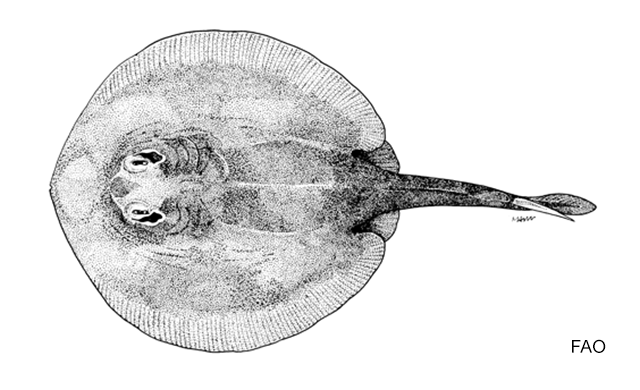Creature
Fast Facts
Introducing you to extinct species.

THE JAVA
STINGAREE
1. The Java stingaree, Urolophus javanicus, is only known from a single female specimen that was 13 inches in length. 2. It was caught off the coast of Jakarta, Indonesia. 3. It had a wider, oval-shaped pectoral fin. The tail had a dorsal fin in front of the stinging spine. It has a leaf-shaped caudal fin. 4. It was brown with a mix of darker and lighter brown spots. 5. It was discovered in a fish market in July 1862 by Eduard von Martens, a German zoologist. 6. He originally named the species Trygonoptera javanica in his journal in 1864. 7. The mouth is bow-shaped, and contains three papillae (nipple-like structures) on the floor. 8. Its teeth are arranged in a quincunx pattern, which is like the five dot pattern on dice. 9. The Java stingaree had five pairs of gills. 10. It was the “first” marine fish to be declared extinct on March 31, 2023. The smooth handfish was declared extinct in 2020, but its status was changed in September 2021 because there was “not enough sufficient data to confirm its status.”
Extinction
Cometh
Facing the light at the end of the tunnel
EXTINCTION DATE
1870's
The Java stingaree was first formally observed by science in 1864 when Eduard von Martens, a German scientist, published his findings of a unique specimen he collected in a Jakarta fish market in July of 1862. He named his new species Trygonoptera javanica. It was later renamed Urolophus javanicus. That specimen was a female of unknown age. Because it was never observed by science in the wild or while alive, its behavior, life cycle, and habitat preferences can only be speculated upon. Many stingaree species are aplacental viviparous, which means the eggs hatch inside the female and they give live birth to a smaller litter. It is thought that habitat degradation and overfishing were the likely causes of its extinction. Although Jurassic Park is fiction, scientists are working on several de-extinction projects. In fact, in 2003 scientists did bring back the extinct Pyrenean ibex, a type of wild goat, for 7 minutes before it died, showing de-extinction is possible. The Java stingaree might be a candidate for this if scientists could collect DNA from the only preserved female specimen collected in 1862. The population of Java is 145 million with 10.5 million living in Jakarta. The waters off the coast of Java are still at risk of being overfished and the habitat is still highly at risk. Although there are some conservation efforts in the area, the effect of human development continues to be a major concern. The Javan tiger was rediscovered in March of 2024 sparking renewed conservation efforts on land. Hopefully, new regulations can find a good balance between feeding a growing population and protecting Java’s unique wildlife on the land and in the water. If the Java stingaree was brought to life, could it ever be reintroduced to its native homeland off the coast of Jakarta in Indonesia?
COMING
SOON
The Java stingaree's Lazarus Tale has yet to be written. Would it be able to thrive again off the coast of Java if it did return?
More to Explore
All answers lead to more questions
VIDEOS & ADDITIONAL INFO
Facts about the Extinct Java Stingaree
Java Stingaree - First Marine Fish Declared Extinct in 2023
Java Singaree Extinction - Video
Nearly 40% of Rays & Sharks are Near Extinction
Australian Sharks & Rays Facts
Information about the Java Stingaree
Information about the Kai stingaree
Tentacled Butterfly Ray Rediscovered in Iran

The only specimen ever collected of the Java stingaree
Image from Mongabay

A sketch of the extinct
Java stingaree
Image from Fish Base

Java stingaree quick facts
Image from Charles Darwin University on X

A graphic showing the trend for shark and ray populations around the world
Image from Nicholas Dulvy on X

Stingaree was a short-lived
DC superhero
Image from Cover Browser

A comic about recently extinct species, including the Java stingaree
Image from Green Humour

The Kai stingaree may also be extinct since it hasn't been documented since two specimens were first collected in 1874
Image from Fish Base

The Sydney skate is part of a series of conservation posters
Image from Australian Marine Conservation Society

A radiograph image taken by the Trustees of the Natural History Museum in London
Image from WoRMS

The Greenback stingaree is part of a series of conservation posters
Image from Australian Marine Conservation Society

The tentacled butterfly ray was thought to be extinct in 1986 until it was Rediscovered in Iran in 2019
Image from UN Biodiversity on X

A specimen of the rediscovered tentacled butterfly ray
Image from Hakai Magazine

The Oakland Skates was part of the Roller Hockey International (RHI) from 1993 - 1996
Image from Tee Public

Tampa Bay joined Major League Baseball (MLB) in 1998 as the Devil Rays. In 2008 they changed their name to the Tampa Bay Rays
Image from CRW Flags

A photo from 1938 in Ujung Kulon showing a living Javan toger
Image from Mongabay



